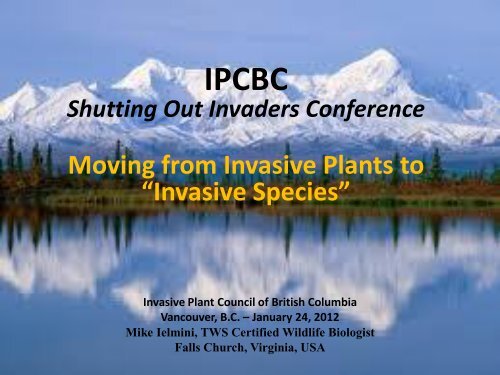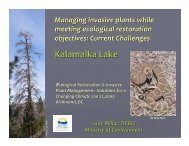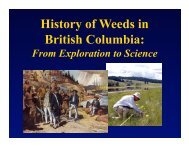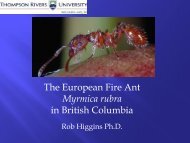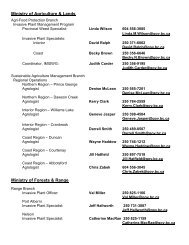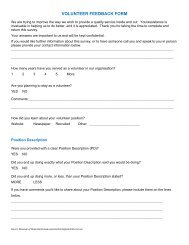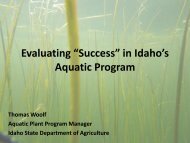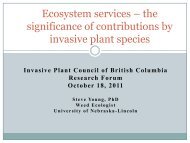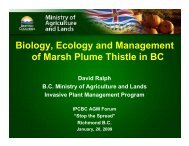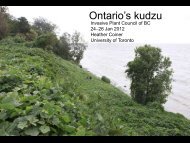National Forest System Invasive Species Management Program ...
National Forest System Invasive Species Management Program ...
National Forest System Invasive Species Management Program ...
You also want an ePaper? Increase the reach of your titles
YUMPU automatically turns print PDFs into web optimized ePapers that Google loves.
IPCBC<br />
Shutting Out Invaders Conference<br />
Moving from <strong>Invasive</strong> Plants to<br />
“<strong>Invasive</strong> <strong>Species</strong>”<br />
<strong>Invasive</strong> Plant Council of British Columbia<br />
Vancouver, B.C. – January 24, 2012<br />
Mike Ielmini, TWS Certified Wildlife Biologist<br />
Falls Church, Virginia, USA
INVASIVE SPECIES
<strong>Invasive</strong> <strong>Species</strong> Threaten<br />
• Biodiversity<br />
• Ecosystem Health<br />
• Soil Stability<br />
• Water quality<br />
• Native Fish and<br />
Wildlife<br />
• Recreational Values<br />
• Human Health<br />
• Communities<br />
• <strong>Forest</strong> Productivity<br />
• Cultural Needs and<br />
Heritage Areas<br />
• Threatened and<br />
Endangered <strong>Species</strong><br />
• Aesthetics<br />
• The Economy<br />
• Lifestyles<br />
• …..and much more
Economic Costs<br />
Pimentel, et al. (1999) –<br />
Over 120,000 non-native species of plants, animals and<br />
microbes have invaded the United States, United<br />
Kingdom, Australia, South Africa, India, and Brazil, and<br />
many have caused major economic losses in agriculture<br />
and forestry as well as negatively impacting ecological<br />
integrity. The estimate is that non-native species<br />
invasions in the six nations are causing more than<br />
US$ 314 billion per year in damages.
Economic Costs<br />
In 2010, The Nature Conservancy<br />
estimated damages from invasive<br />
species worldwide totaled more than<br />
$1.4 Trillion – five percent of the<br />
global economy.
Our Future is At Stake
The Big Picture
Water<br />
Insects<br />
Plants<br />
Mammals<br />
Birds<br />
Air<br />
Fish<br />
Microbes<br />
Plants<br />
Soil<br />
Sun<br />
Humans<br />
Mollusks<br />
Reptiles<br />
Amphibians<br />
Crusteaceans
Moving from <strong>Invasive</strong> Plants<br />
to<br />
<strong>Invasive</strong> <strong>Species</strong>
The Vision<br />
What are we trying to<br />
achieve<br />
“Healthy and resilient British<br />
Columbia landscapes,<br />
free of the negative impacts of<br />
invasive species”
These invaders undermine almost every effort to<br />
conserve, protect, or sustain these landscapes for<br />
future generations.<br />
Lifestyles are being impacted
Basic Concept<br />
Everything in the Ecosystem<br />
is Connected
Basic Concept<br />
…..and the impact of our activities<br />
across the landscape are connected<br />
and magnified when we join together<br />
against the common interests.
…..Therefore, it is critical to<br />
INTEGRATE AND COORDINATE<br />
those activities to<br />
Maximize Effectiveness
“Collaboration exemplifies the<br />
value of synergy and coordination<br />
to increase efficiency and<br />
effectiveness in meeting a common<br />
goal” – BC I.S. Strategy
Basic Concepts<br />
1. Nobody can do this alone<br />
2. Everyone has limited capacity<br />
3. We need to work together and share<br />
resources<br />
Therefore, It is Critical to<br />
Leverage Existing Capacity and Capabilities
It Will Not Be Easy<br />
to Coordinate or Cooperate<br />
There will be resistance to sharing,<br />
communicating, and partnering<br />
Driven by insecurity<br />
and<br />
competition for limited resources
Different Interests<br />
Different Values<br />
Different Perspectives<br />
Different Capabilities<br />
Different Strengths<br />
Different Weaknesses
Communication<br />
• There is usually too little rather than too much<br />
• Recognize your communication limitations<br />
and strive for improvement.<br />
• Ask for help if you can’t reach your intended<br />
audience.<br />
• Think outside your box with messaging and<br />
marketing.<br />
• Overcome your biases wherever possible
COMMON GROUND IS NOT HARD<br />
TO FIND<br />
As long as you don’t have<br />
“20/20 Tunnel Vision”
THERE IS STRENGTH IN<br />
DIVERSITY<br />
AND PARTNERSHIPS WITH<br />
NON-TRADITIONAL STAKEHOLDERS<br />
You have the power<br />
to unlock the doors that keep you<br />
ISOLATED
Strategic <strong>Invasive</strong> <strong>Species</strong><br />
<strong>Management</strong> Elements<br />
ARE NOT UNIQUE<br />
TO ONLY ONE SPECIES GROUP<br />
And can often happen in the same<br />
geographic area
Basic <strong>Management</strong> Elements<br />
and Activities<br />
• Prevention (#1)<br />
• Early Detection and Rapid Response (#2)<br />
• Control and <strong>Management</strong><br />
• Restoration and Rehabilitation (Pre- and Post-Invasion)<br />
• Surveys, Inventories, Mapping, and Monitoring<br />
• Research and Technology Development<br />
• Education and Information Transfer<br />
• Partnerships and Coordination
Basic Approach<br />
<strong>Invasive</strong> species management across the<br />
landscape should be approached in the same<br />
context as “safety”….<br />
….integrated into each program and facet of<br />
our activities on the landscape. Everyone can<br />
take part in the battle against the invasive<br />
species threat in their own small way.
<strong>Invasive</strong> <strong>Species</strong> <strong>Management</strong><br />
“A Means To and End”
Integration: <strong>Invasive</strong> Survey, Inventory & Treatment
<strong>Management</strong> Activity Subunits<br />
Subunit 004<br />
Activity:2550<br />
Biocontrol-Classic<br />
Insect Release<br />
<strong>Invasive</strong> Plant<br />
Subunit 000<br />
Subunit 001<br />
Activity: 2510<br />
Pesticide Application<br />
Exotic Fish<br />
Subunit 002<br />
Activity 2530<br />
Trapping<br />
<strong>Invasive</strong> Vertebrate<br />
Subunit 003<br />
Activity 2510<br />
Pesticide Application<br />
<strong>Invasive</strong> Plant
Acres Infested<br />
Control Costs<br />
Eradication unlikely,<br />
intense effort required<br />
<strong>Invasive</strong> <strong>Species</strong> Increase Over Time and Control Potential<br />
Eradication<br />
feasible<br />
Local control and<br />
management only<br />
Eradication<br />
simple<br />
Public Awareness<br />
typically begins here<br />
Introduction<br />
Detection<br />
Plant absent<br />
Scattered<br />
locations<br />
Time<br />
Numerous<br />
locations<br />
At or near biological potential
Acres Infested<br />
Control Costs<br />
Eradication unlikely,<br />
intense effort required<br />
<strong>Invasive</strong> <strong>Species</strong> Increase Over Time and Control Potential<br />
Eradication<br />
feasible<br />
Local control and<br />
management only<br />
Eradication<br />
simple<br />
Public Awareness can<br />
be happen sooner with<br />
broader coalitions<br />
Introduction<br />
Detection<br />
Plant absent<br />
Scattered<br />
locations<br />
Time<br />
Numerous<br />
locations<br />
At or near biological potential
The Basics of How To Make A<br />
Raise Awareness of the<br />
Threat in All Circles<br />
Network and Share<br />
Resources<br />
Be Tenacious and<br />
Vigilant<br />
Plan and Act for the<br />
Long-Term<br />
Difference:
Raise Awareness
Network and Share Resources<br />
Cooperate and Collaborate<br />
Not<br />
Coordinated<br />
Well Coordinated<br />
and Effective
Tenacity and Vigilance
Never underestimate the power of a few<br />
committed people to change the world.<br />
Indeed, it is the only thing that ever has.<br />
- Margaret Mead
Long-Range Strategic<br />
Planning
Please,<br />
THEIR FUTURE<br />
Is At Stake
IPCBC<br />
Shutting Out Invaders Conference<br />
Moving from <strong>Invasive</strong> Plants to<br />
“<strong>Invasive</strong> <strong>Species</strong>”<br />
<strong>Invasive</strong> Plant Council of British Columbia<br />
Vancouver, B.C. – January 24, 2012<br />
Mike Ielmini, TWS Certified Wildlife Biologist<br />
Falls Church, Virginia, USA


